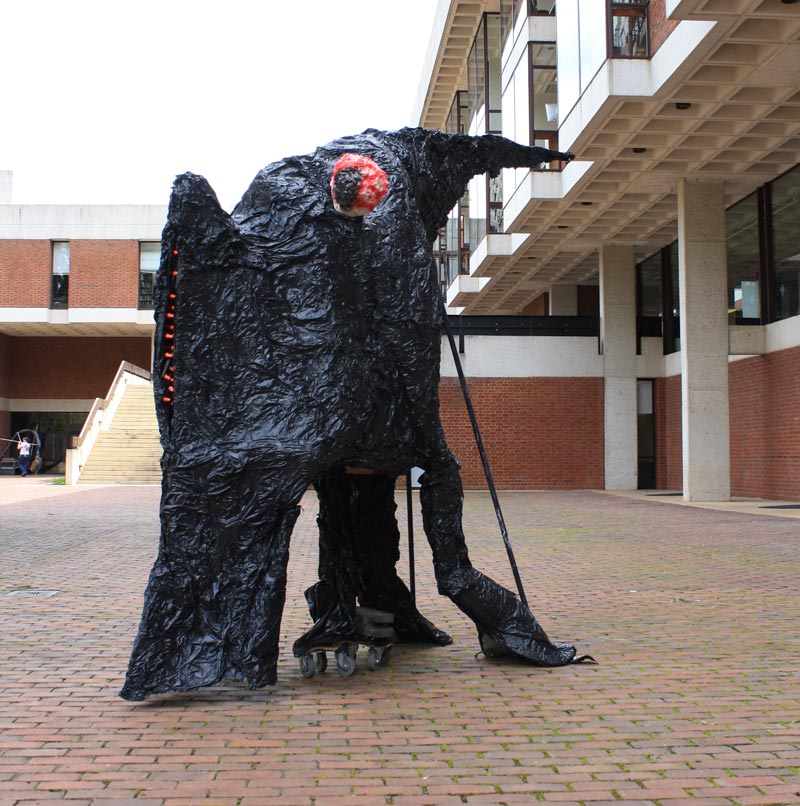Monster Mash
Modern-day Dr. Frankensteins bring creatures to life
The four students toiled in the lab for three days before their creature came alive. The only things missing were menacing flashes of lightning, a hunch-backed assistant named Igor and eerie organ music to accompany their work.
The four, all students in the Art of the Moving Creature course, first sketched their ideas and constructed a clay model. Then, channeling their inner mad scientists, the students began to build.

Quincy sat in the corner of the drama studio until two of its creators, Jess Burnam (Col ’14) and Mark Molchany, camouflaged in garbage bags to match the monster’s asphalt-like skin, stepped inside the monster to move its wild red eyes and propel it slowly forward while Jake Fox (Arch ’17) and Jake Kvanbeck (Grad ’18) manipulated its hind legs from the outside.
"Activating [the creature] and getting inside brings life to it," says Fox, a landscape architecture student.
So far, the students have produced about a dozen gigantic monsters, and more are on the way.
The yearlong interdisciplinary course sprouted from an Arts in Action grant proposal and is cross-listed in the School of Architecture and the College of Arts & Sciences' Drama and Studio Art departments.
"This class is all about thinking through making," says Melissa Goldman, the Architecture School's fabrication facilities manager, who leads the class along with Steven Warner, technical director of the Department of Drama, and Eric Schmidt, the studio and gallery technician of the McIntire Department of Art. "We cover the whole gamut, from theory to practice."

"They feed off of one another," says Schmidt. During workshops, students buzz around their projects, talking, tweaking, making, asking questions and finding answers.

"It's through movement and environment that people start to make connections with creatures,"says Goldman.
They studied gait analysis with a biomechanics professor and conflict in movement from a dance professor. They studied with Shane Mahan and Peter Weir Clarke, master monster makers from the Stan Winston School of Character Arts who came to Grounds in September to help out with an early creature workshop. Mahan and Clarke helped fashion Quincy's trash bag epidermis and showed students how to make the most out of the materials available in the Arts Grounds workshops.
"You can get pretty far with PVC pipe and garbage bags," says Fox, who adds that having such a limited palette of supplies can both fuel and challenge the creative process.
This is the first time that the three Arts Grounds studios have participated in a project together, but Goldman, Schmidt and Warner expect that it won't be the last. People from the University and Charlottesville communities have expressed great interest in the project—the monsters have appeared at a McGuffey Art Center block party and will creep down the Lawn during this year's trick-or-treating event.

In the spring, students will refine the design and the form of their original creatures and present them in a performance at the Stan Winston Arts Festival of the Moving Creature on April 20, 2013. The festival will showcase the students' work, but it will also honor the late Stan Winston (Col ’68). After graduating from UVA, he moved to California and established Stan Winston Studios, one of Hollywood's premiere special effects studios. He was responsible for some of cinema's most extraordinary creatures: Jurassic Park dinosaurs, Terminator robots and Edward Scissorhands, to name just a few.
Winston began to hone his craft here at the University—he studied drama and sculpture and also was a make-up artist for many drama productions, says Schmidt. The Arts Grounds departments hope to foster that same mode of imaginative, cross-disciplinary thinking.
"If students are "working in a collective imagination, then they go beyond the places that any one person could have thought on his or her own," says Goldman, "and that's what we're hoping to inspire here."